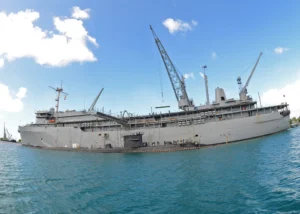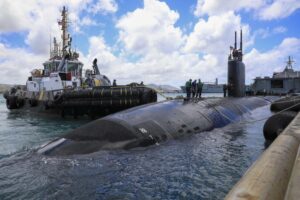The Defense Department plans to enlarge its submarine operating capability from Guam in the coming decade to help counter China’s growing naval capabilities, the head of U.S. submarines in the Pacific said recently.
“Over the next five to 10 years we’re going to expand our submarine operating capability from Guam to optimize our presence in the Western Pacific for warfighting capacity,’ Rear Adm. Jeffrey Jablon, commander of Submarine Force under the U.S. Pacific Fleet, said during the annual Naval Submarine League’s symposium on Nov. 2.

He noted his command currently has five attack submarines deployed in the Western Pacific, after adding the Los Angeles-class USS Springfield (SSN-761) in March.
Jablon said the submarines are “conducting missions vital to national security while preparing and walking the battlespace” while he has eight submarines in the local operating areas working up for those deployments.
“And I have three additional submarines in the Guam operating areas working up for their upcoming deployments,” he added.
Jablon underscored beyond the five deployed submarines the Navy will expand Guam submarine capabilities.
“Looking to the future, we are going to expand our submarine operating capability from Guam to optimize our presence and warfighting capacity in the Western Pacific. This is going to include augmenting our maintenance capacity with the necessary facilities, infrastructure and personnel, building additional pier facilities and services and expanding the capabilities of our shore-based training facilities in Guam.”
The improvements he outlined occurring in the next five to 10 years coincides with what some Navy officials call the “decade of maximum danger.”
Jablon said that “refers to the [People’s Republic of China’s] growth and aspirations in the Indo-Pacific region, and specifically the goal of unifying Taiwan with mainland China.”
“We’ve heard we’re at an inflection point. It’s a critical decade. It’s a decisive decade. And it’s true. That is my number one concern as the Pacific Fleet Force Commander for the Submarine Force. We are in the decade of maximum danger. China has fielded the largest Navy in the world, guaranteeing its numerical advantage in the South and East China Seas.”
He added that as the People’s Liberation Army Navy (PLAN) surface fleet and undersea force improves their capabilities, “we will intensify our efforts to prepare our undersea force to deter, and if necessary, defeat the PLAN. Sea control and sea denial from beneath the seas is one of our core advantages, and we will not yield any ground to our competitors.”
Jablon underscored both of the Navy’s submarine tenders, the USS Frank Cable (AS-40) and Emory S. Land (AS-39), are stationed in Guam to support the submarine forces.

He pointed out earlier in 2022 the Frank Cable did a rearming and reloading exercise with the Springfield and a Royal Australian Navy Collins-class submarine, the HMAS Farncomb (SSG-74).
Jablon said the current plan for the submarine tenders is for them to be replaced in the late 2020s.
“Both the Emory S. Land and the Frank Cable will be in operation until that tender turnover. So there will not be a gap in our tender capabilities.”
Jablon also said the Collins-class boats are “extremely capable and we have interoperability with the Australian submarine force, conducting missions common to the submarine force, both the United States and the Australians.”
Australia plans to ultimately replace the conventionally-powered Collins-class submarines with nuclear-powered attack submarines as part of the AUKUS cooperative agreement with the U.S. and U.K.